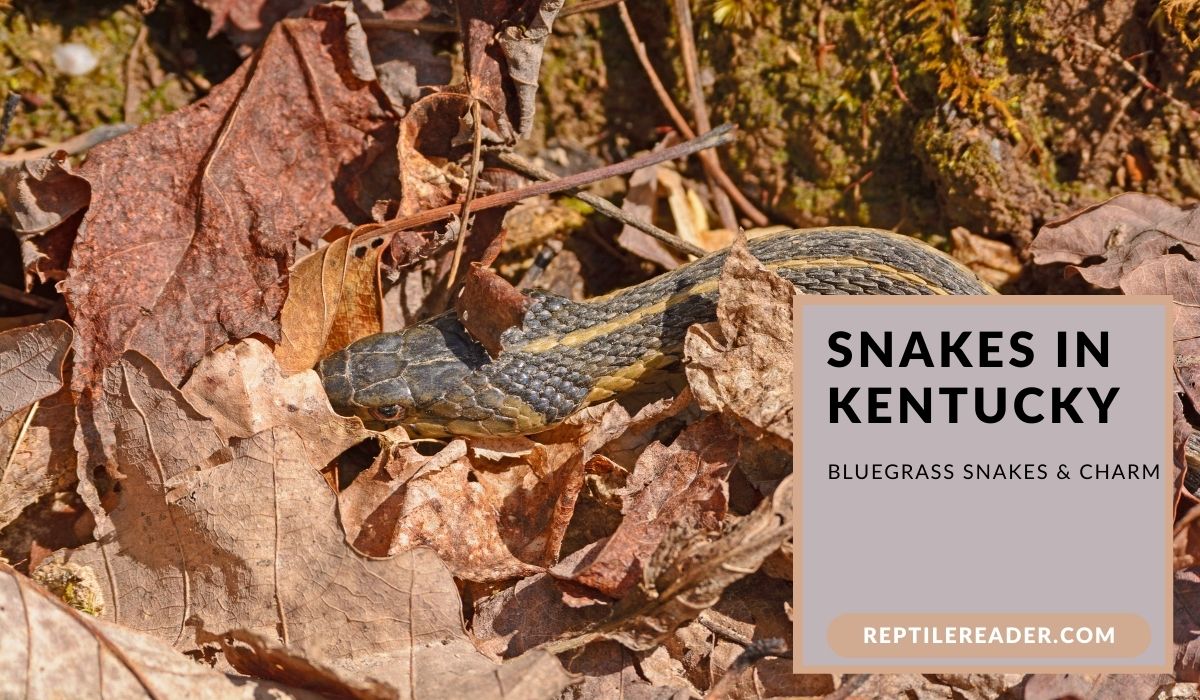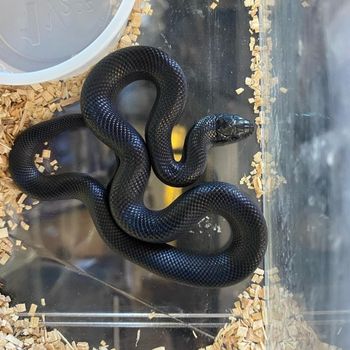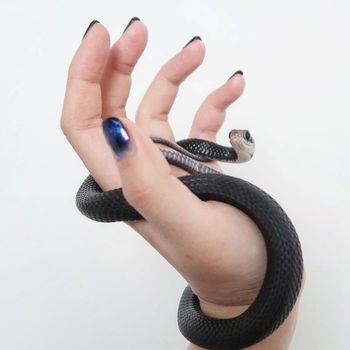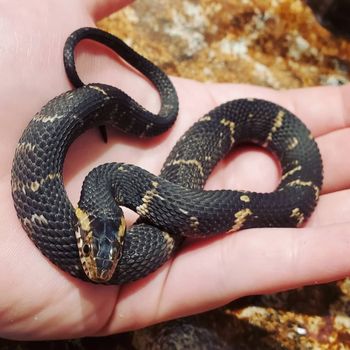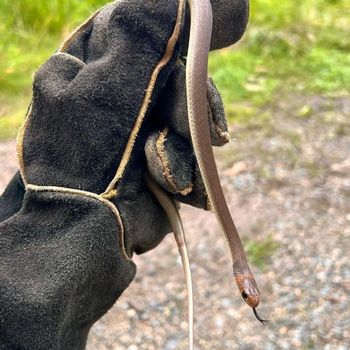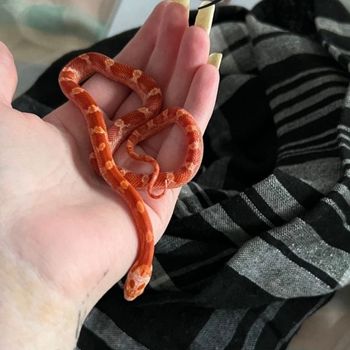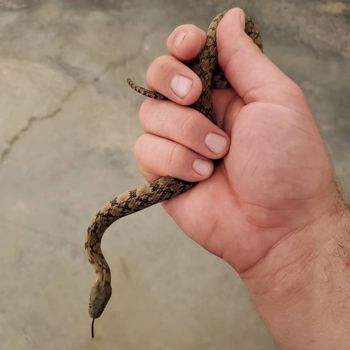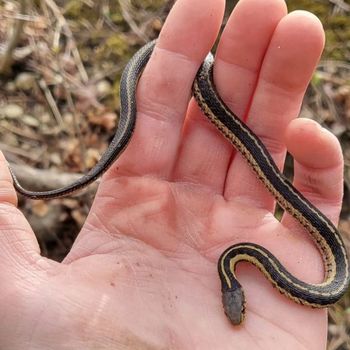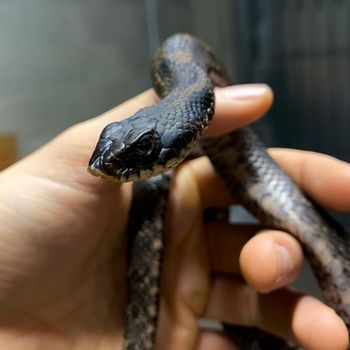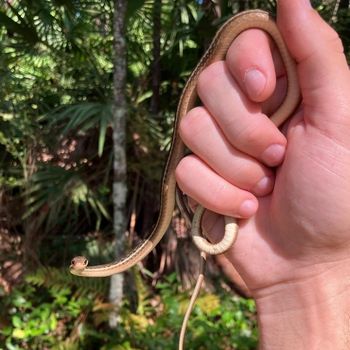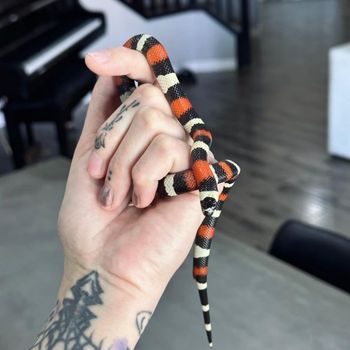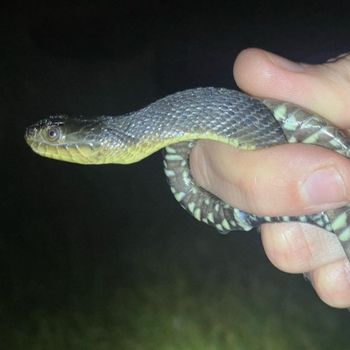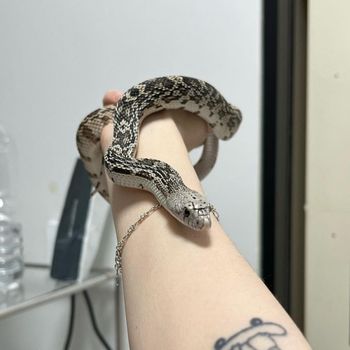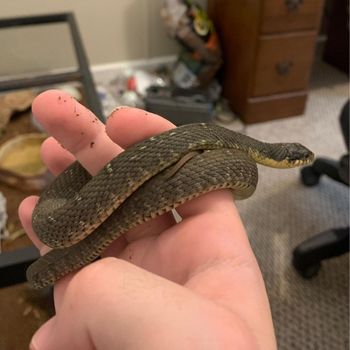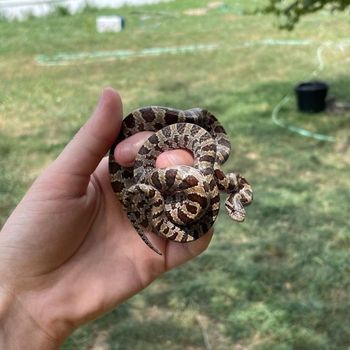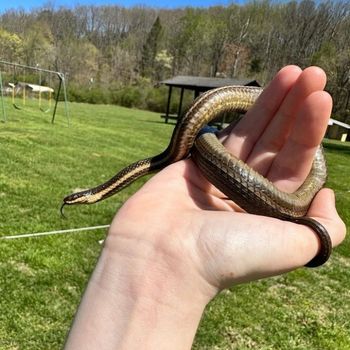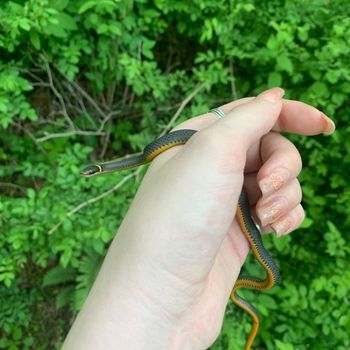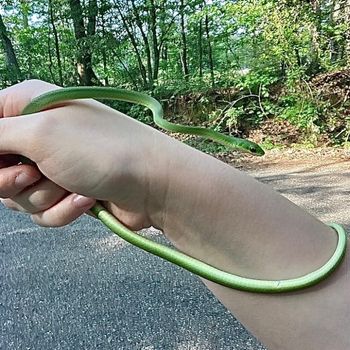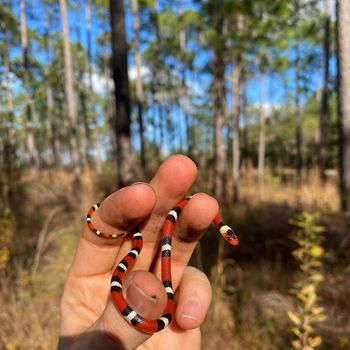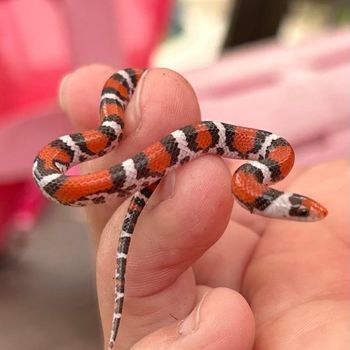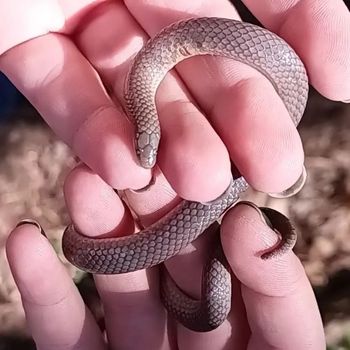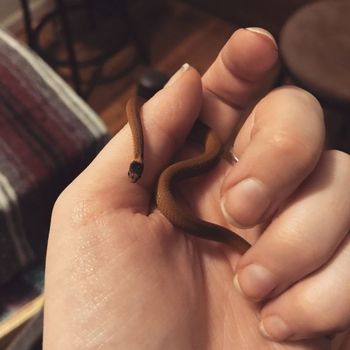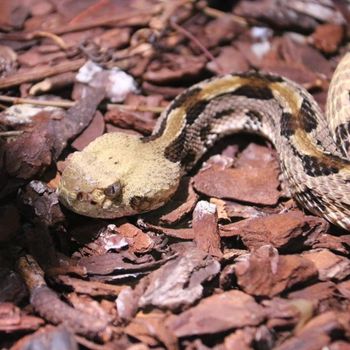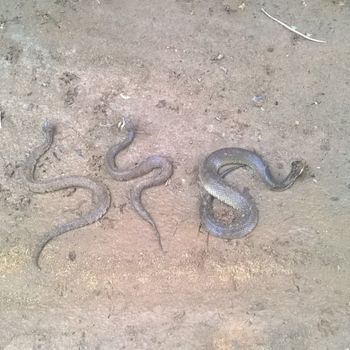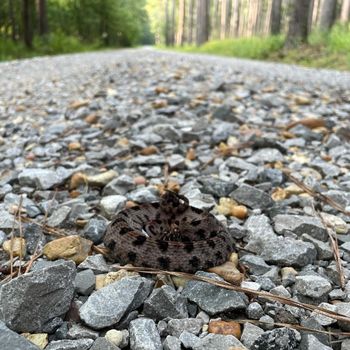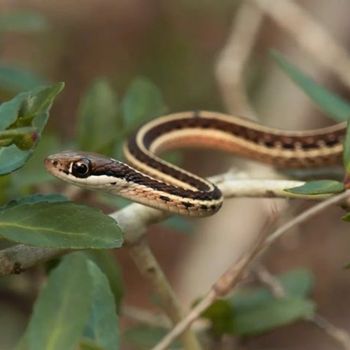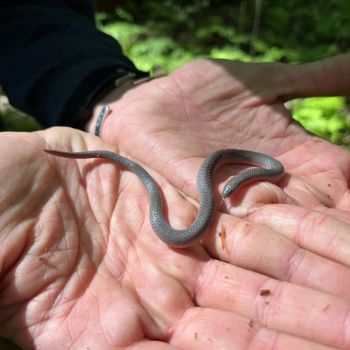Snakes in Kentucky: Bluegrass Snakes & Charm
So, you’re curious about the slithering inhabitants of the Bluegrass State, huh? Well, buckle up, because Kentucky is home to a fascinating variety of serpentine species that will make your reptile-loving heart sing.
That’s right, there are 33 different species of snakes waiting for you to discover and appreciate in the beautiful state of Kentucky. From venomous vipers to charming constrictors, there’s a little bit of everything for snake admirers of all levels.
Ready to learn more? Can’t wait to dive into the world of Kentucky snakes? Stay tuned as we unravel the mystery of these spectacular creatures and find out what makes them unique!
| # | Name | Details | Image |
| 1 | Black Kingsnake (Lampropeltis nigra) |
| 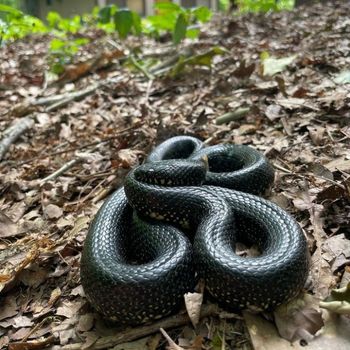 |
| 2 | Black Racer (Coluber constrictor constrictor) |
| 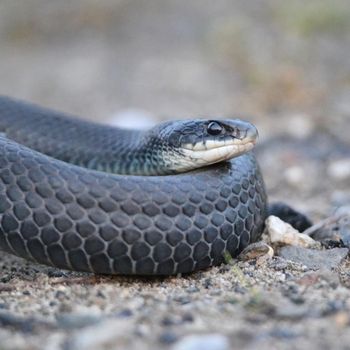 |
| 3 | Black Rat Snake (Pantherophis obsoletus) |
| 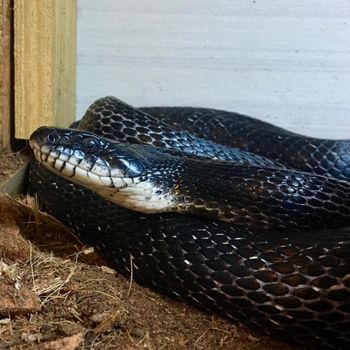 |
| 4 | Broad-banded Water Snake (Nerodia fasciata confluens) |
| 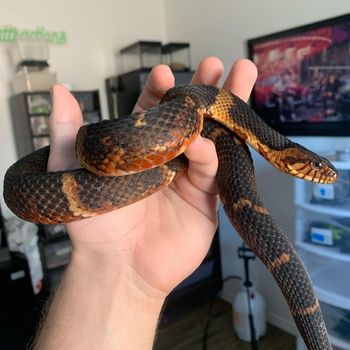 |
| 5 | Brownsnake (Pseudonaja textilis) |
| 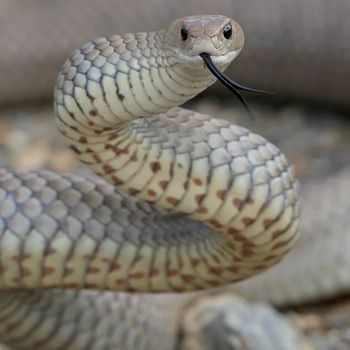 |
| 6 | Copperbelly Water Snake (Nerodia erythrogaster neglecta) |
| 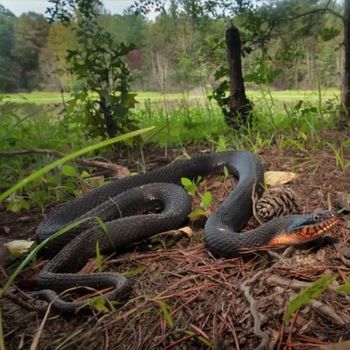 |
| 7 | Copperhead (Agkistrodon contortrix) |
| 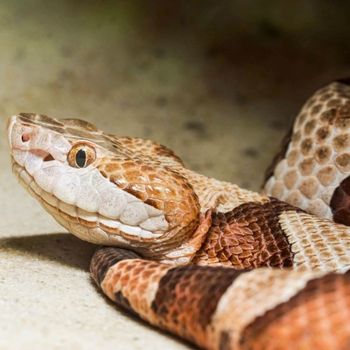 |
| 8 | Corn Snake (Pantherophis guttatus) |
| 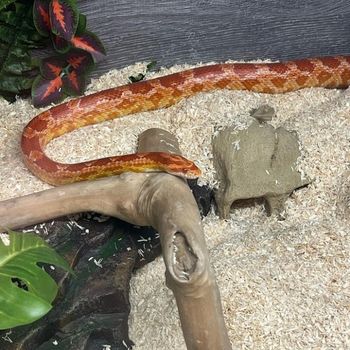 |
| 9 | Diamond-backed Water Snake (Nerodia rhombifer) |
| 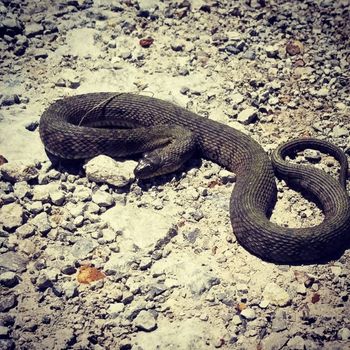 |
| 10 | Eastern Garter Snake (Thamnophis sirtalis sirtalis) |
| 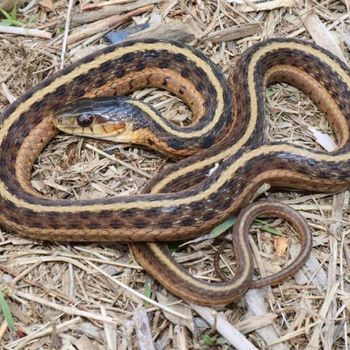 |
| 11 | Eastern Hog-nosed Snake (Heterodon platirhinos) |
| 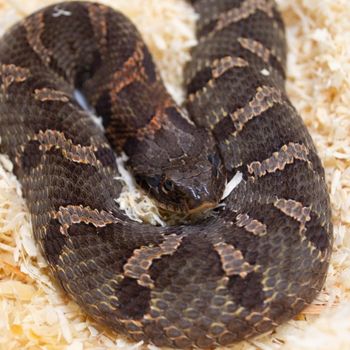 |
| 12 | Eastern Ribbon Snake (Thamnophis sauritus sauritus) |
|  |
| 13 | Kirtland’s Snake (Clonophis kirtlandii) |
| 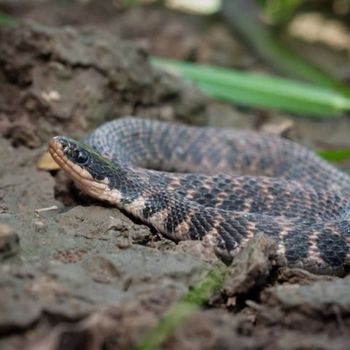 |
| 14 | Milksnake (Lampropeltis triangulum) |
| 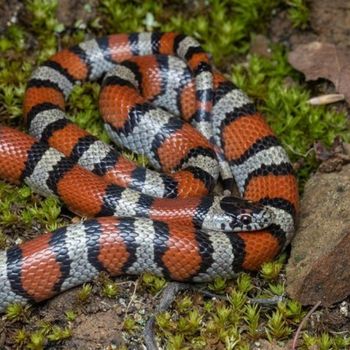 |
| 15 | Mississippi Green Water Snake (Nerodia cyclopion) |
|  |
| 16 | Northern Pine Snake (Pituophis melanoleucus) |
| 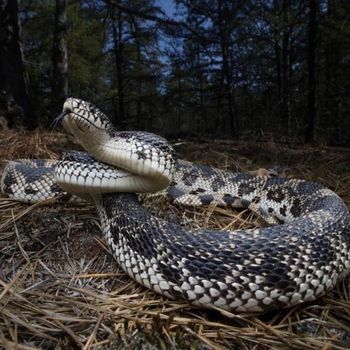 |
| 17 | Northern Red-bellied Snake (Storeria occipitomaculata occipitomaculata) |
|  |
| 18 | Northern Water Snake (Nerodia sipedon) |
|  |
| 19 | Plain-bellied Watersnake (Nerodia erythrogaster) |
| 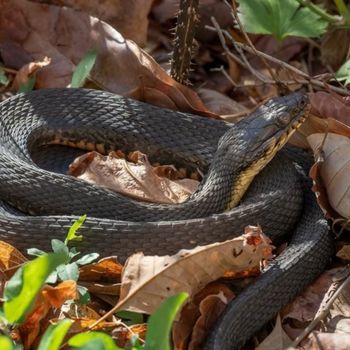 |
| 20 | Prairie Kingsnake (Lampropeltis calligaster) |
|  |
| 21 | Queen Snake (Regina septemvittata) |
| 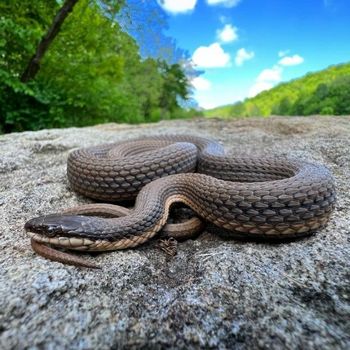 |
| 22 | Ringneck Snake (Diadophis punctatus) |
|  |
| 23 | Rough Green Snake (Opheodrys aestivus) |
| 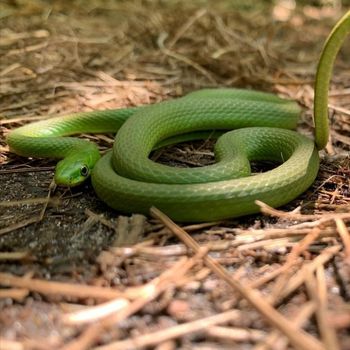 |
| 24 | Scarlet Kingsnake (Lampropeltis elapsoides) |
| 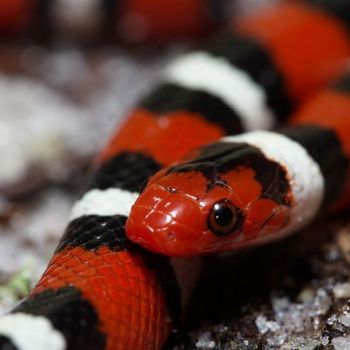 |
| 25 | Scarlet Snake (Cemophora coccinea) |
| 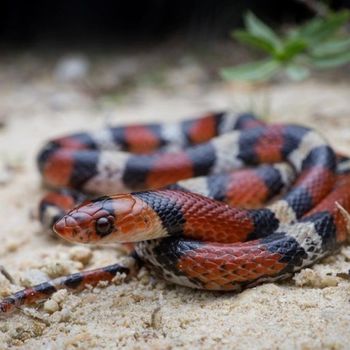 |
| 26 | Smooth Earth Snake (Virginia valeriae) |
| 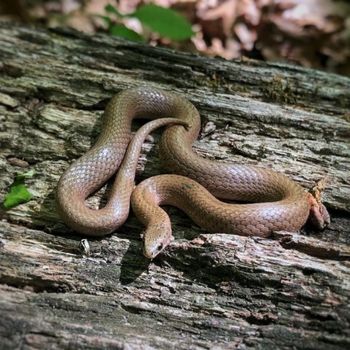 |
| 27 | Southeastern Crowned Snake (Tantilla coronata) |
| 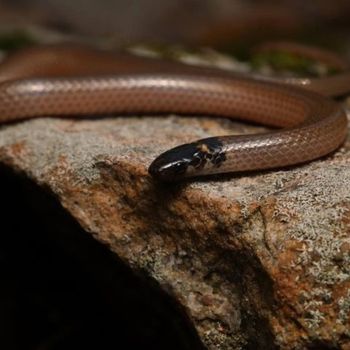 |
| 28 | Timber Rattlesnake (Crotalus horridus) |
|  |
| 29 | Western Cottonmouth (Agkistrodon piscivorus leucostoma) |
| 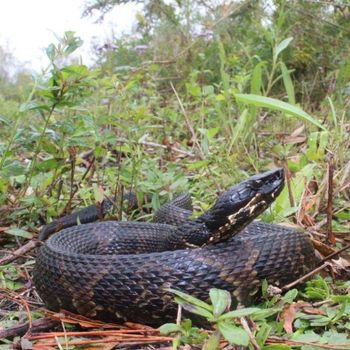 |
| 30 | Western Mud Snake (Farancia abacura reinwardtii) |
| 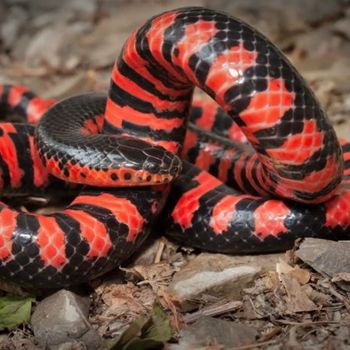 |
| 31 | Western Pygmy Rattlesnake (Sistrurus miliarius streckeri) |
| 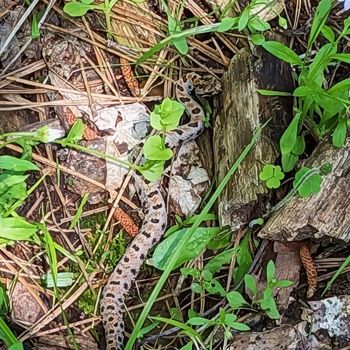 |
| 32 | Western Ribbonsnake (Thamnophis proximus) |
| 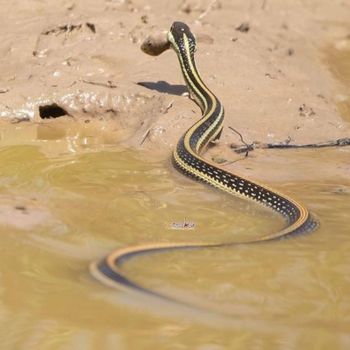 |
| 33 | Worm Snake (Leptotyphlops humilis) |
| 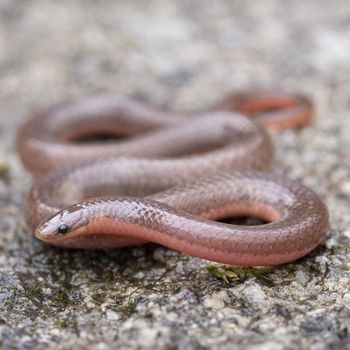 |
33 Snakes You Can Find in Kentucky
In the state of Kentucky, a fascinating array of serpents can be found slithering through its diverse landscapes. From venomous to harmless, each species has its unique story to tell. Below, we’ll explore the wonders of these often misunderstood creatures of Kentucky, from their natural habitats and behaviors to the challenges they face in our changing world.
1. Black Kingsnake
- Scientific Name: Lampropeltis nigra
- Common Name: Black kingsnake
- Size: Up to 4 feet (1.2 meters)
- Natural Habitat: Woodlands, forests, and grasslands
- Color: Solid black with white speckles
- Habitat: Woodlands, forests, and grasslands
- Maximum Size: Up to 4 feet (1.2 meters)
- Diet: Mammals, reptiles, amphibians, and birds
- Reproduction: Lay eggs in clutches of 5-20
- Venom: Non-venomous
- Conservation: Least concern
The Black Kingsnake (Lampropeltis nigra) is a non-venomous snake that can grow up to 4 feet (1.2 meters) long, featuring a solid black color with white speckles. Commonly found in woodlands, forests, and grasslands of Kentucky, these nocturnal and terrestrial creatures have a diverse diet including mammals, reptiles, amphibians, and birds. They reproduce by laying eggs in clutches of 5-20. Currently, their conservation status is listed as least concern, indicating a stable population in the wild.
2. Black Racer
- Scientific Name: Coluber constrictor constrictor
- Common Name: Black racer
- Size: Up to 6 feet (1.8 meters)
- Natural Habitat: Various habitats, including forests, grasslands, and urban areas
- Color: Solid black with white chin
- Habitat: Various habitats, including forests, grasslands, and urban areas
- Maximum Size: Up to 6 feet (1.8 meters)
- Diet: Rodents, lizards, frogs, and insects
- Reproduction: Lay eggs in clutches of 12-30
- Venom: Non-venomous
- Conservation: Least concern
The Black Racer (Coluber constrictor constrictor) is a non-venomous snake species of Kentucky reaching up to 6 feet (1.8 meters) in length, featuring a solid black coloration and a striking white chin. It thrives in an array of habitats, including forests, grasslands, and urban areas. As a diurnal and swift-moving snake, it feeds on rodents, lizards, frogs, and insects. They reproduce by laying eggs in clutches of 12-30, and are currently designated as a species of least concern in terms of conservation status.
3. Black Rat Snake
- Scientific Name: Pantherophis obsoletus
- Common Name: Black rat snake
- Size: Up to 8 feet (2.4 meters)
- Natural Habitat: Forests, grasslands, and urban areas
- Color: Black with faint dark blotches
- Habitat: Forests, grasslands, and urban areas
- Maximum Size: Up to 8 feet (2.4 meters)
- Diet: Rodents, birds, and eggs
- Reproduction: Lay eggs in clutches of 5-30
- Venom: Non-venomous
- Conservation: Least concern
Pantherophis obsoletus, commonly known as Black Rat Snake, can grow up to 8 feet (2.4 meters) long, with a black and dark-blotched coloring. These non-venomous reptiles inhabit forests, grasslands, and urban areas of Kentucky, showcasing diurnal and semi-arboreal behavior. Their diet consists of rodents, birds, and eggs. Female Black Rat Snakes lay eggs in clutches of 5-30 during the reproduction season. Although not endangered, these snakes play an important role in controlling rodent populations.
4. Broad-banded Water Snake
- Scientific Name: Nerodia fasciata confluens
- Common Name: Broad-banded water snake
- Size: 24-42 inches (61-106 cm)
- Natural Habitat: Aquatic habitats, including lakes, ponds, streams, and swamps
- Color: Brown or gray with dark bands
- Habitat: Aquatic habitats, including lakes, ponds, streams, and swamps
- Maximum Size: 24-42 inches (61-106 cm)
- Diet: Fish and amphibians
- Reproduction: Viviparous, 8-58 offspring per litter
- Venom: Non-venomous
- Conservation: Least concern
The Broad-banded Water Snake (Nerodia fasciata confluens) is a non-venomous aquatic snake inhabiting lakes, ponds, streams, and swamps. Measuring 24-42 inches (61-106 cm) in length, its color ranges from brown to gray with dark bands. Being diurnal and semi-aquatic, its diet consists of fish and amphibians. This viviparous species has 8-58 offspring per litter with a conservation status of Least Concern.
5. Brownsnake
- Scientific Name: Pseudonaja textilis
- Common Name: Eastern brown snake
- Size: Up to 7 feet (2.1 meters)
- Natural Habitat: Grasslands, woodlands, and urban areas
- Color: Light brown to dark brown, sometimes reddish
- Habitat: Grasslands, woodlands, and urban areas
- Maximum Size: Up to 7 feet (2.1 meters)
- Diet: Small mammals, birds, reptiles, and amphibians
- Reproduction: Lay eggs in clutches of 10-35
- Venom: Highly venomous
- Conservation: Least concern
The Eastern Brown Snake (Pseudonaja textilis) is a large, highly venomous snake species, reaching sizes of up to 7 feet (2.1 meters). Its color ranges from light brown to dark brown, and occasionally reddish hues. Inhabiting grasslands, woodlands, and urban areas, these diurnal, terrestrial snakes primarily feed on small mammals, birds, reptiles, and amphibians. They reproduce by laying eggs in clutches of 10-35. Despite their venomous nature, their conservation status is considered “least concern.”
6. Copperbelly Water Snake
- Scientific Name: Nerodia erythrogaster neglecta
- Common Name: Copperbelly water snake
- Size: Up to 4.5 feet (1.37 meters)
- Natural Habitat: Wetland habitats, such as marshes, swamps, and ponds
- Color: Copper-red or orange on the belly, dark brown or black on the back
- Habitat: Wetland habitats, such as marshes, swamps, and ponds
- Maximum Size: Up to 4.5 feet (1.37 meters)
- Diet: Fish and amphibians
- Reproduction: Lay eggs in clutches of 10-30
- Venom: Non-venomous
- Conservation: Threatened
Copperbelly Water Snake (Nerodia erythrogaster neglecta) is a non-venomous reptile that grows up to 4.5 feet (1.37 meters) long. Sporting a distinctive copper-red or orange belly and dark brown or black back, this semi-aquatic, nocturnal snake inhabits wetland areas, such as marshes, swamps, and ponds. It primarily feeds on fish and amphibians. Copperbelly Water Snakes reproduce by laying eggs in clutches of 10-30. Currently, their conservation status is considered threatened.
7. Copperhead
- Scientific Name: Agkistrodon contortrix
- Common Name: Copperhead
- Size: Up to 3 feet (0.9 meters)
- Natural Habitat: Forests, swamps, rocky terrain, and riverside habitats
- Color: Coppery-brown with reddish-brown or dark hourglass-shaped bands
- Habitat: Forests, swamps, rocky terrain, and riverside habitats
- Maximum Size: Up to 3 feet (0.9 meters)
- Diet: Rodents, birds, frogs, and insects
- Reproduction: Give live birth to 2-18 young in late summer or early fall
- Venom: Venomous, but relatively mild compared to other venomous snakes
- Conservation: Least concern
The Copperhead (Agkistrodon contortrix) is a venomous snake up to 3 feet (0.9 meters) long, known for its coppery-brown coloring with reddish-brown or dark hourglass-shaped bands. Inhabiting forests, swamps, rocky terrain, and riverside habitats, these solitary and primarily nocturnal creatures prey on rodents, birds, frogs, and insects. Copperheads give live birth to 2-18 young in late summer or early fall. Though venomous, their venom is relatively mild compared to other venomous snakes. Their conservation status is of least concern.
8. Corn Snake
- Scientific Name: Pantherophis guttatus
- Common Name: Corn snake
- Size: 24-72 inches (61-183 cm)
- Natural Habitat: Woodlands, grasslands, and abandoned buildings
- Color: Orange or brownish-yellow with red or brown blotches
- Habitat: Woodlands, grasslands, and abandoned buildings
- Maximum Size: 24-72 inches (61-183 cm)
- Diet: Rodents, birds, and eggs
- Reproduction: Lay eggs in clutches of 10-30
- Venom: Non-venomous
- Conservation: Least concern
The Corn Snake (Pantherophis guttatus) is a non-venomous North American species, ranging from 24-72 inches in length. Their striking coloration consists of an orange or brownish-yellow base with red or brown blotches. Inhabiting woodlands, grasslands, and abandoned buildings, these nocturnal and terrestrial creatures feed primarily on rodents, birds, and eggs. Corn Snakes reproduce by laying egg clutches of 10-30, and have a conservation status of Least Concern.
9. Diamond-backed Water Snake
- Scientific Name: Nerodia rhombifer
- Common Name: Diamond-backed water snake
- Size: 30-48 inches (76-122 cm)
- Natural Habitat: Freshwater habitats, lakes, rivers, and swamps
- Color: Olive-green or brown with dark diamond patterns
- Habitat: Freshwater habitats, lakes, rivers, and swamps
- Maximum Size: 30-48 inches (76-122 cm)
- Diet: Fish, amphibians, and small reptiles
- Reproduction: Live birth, 13-60 young per litter
- Venom: Non-venomous
- Conservation: Least concern
The Diamond-backed Water Snake (Nerodia rhombifer) is a non-venomous reptile measuring 30-48 inches (76-122 cm) in length. Its olive-green or brown skin features dark diamond patterns, providing excellent camouflage in its freshwater habitat which includes lakes, rivers, and swamps. As a diurnal and nocturnal creature, this adept swimmer mainly feeds on fish, amphibians, and small reptiles. The species reproduces through live birth, with each litter consisting of 13-60 young. Currently, it holds a conservation status of Least Concern.
10. Eastern Garter Snake
- Scientific Name: Thamnophis sirtalis sirtalis
- Common Name: Eastern garter snake
- Size: Up to 2-4.5 feet (0.6-1.4 meters)
- Natural Habitat: Forests, grasslands, wetlands, and urban areas
- Color: Brown, green or gray with three yellow stripes
- Habitat: Forests, grasslands, wetlands, and urban areas
- Maximum Size: Up to 2-4.5 feet (0.6-1.4 meters)
- Diet: Earthworms, amphibians, fish, and small mammals
- Reproduction: Lay eggs in clutches of 10-40
- Venom: Mildly venomous but harmless to humans
- Conservation: Least concern
The Eastern Garter Snake (Thamnophis sirtalis sirtalis) is a commonly found snake species that can grow up to 2-4.5 feet (0.6-1.4 meters) in length. It displays a brown, green, or gray coloration adorned with three yellow stripes. Inhabitants of forests, grasslands, wetlands and urban areas, these diurnal and terrestrial reptiles primarily feed on earthworms, amphibians, fish, and small mammals. Eastern Garter Snakes reproduce by laying 10-40 eggs per clutch, and although they are mildly venomous, their venom poses little risk to humans. They are currently classified under the least concern category in conservation status.
11. Eastern Hog-nosed Snake
- Scientific Name: Heterodon platirhinos
- Common Name: Eastern hog-nosed snake
- Size: 20-33 inches (51-84 cm)
- Natural Habitat: Woodlands, grasslands, and sandy areas
- Color: Highly variable, typically brown or gray with dark blotches
- Habitat: Woodlands, grasslands, and sandy areas
- Maximum Size: 20-33 inches (51-84 cm)
- Diet: Mostly toads, but also other amphibians and small mammals
- Reproduction: Lay eggs, 4-60 per clutch
- Venom: Mild venom, harmless to humans
- Conservation: Least concern
The Eastern Hog-nosed Snake (Heterodon platirhinos) is a moderately-sized serpent, reaching lengths of 20-33 inches (51-84 cm). Its coloration is highly variable, typically exhibiting brown or gray hues with dark blotches. Inhabiting woodlands, grasslands, and sandy areas, this diurnal snake is known for playing dead when threatened. Its diet mainly consists of toads, along with other amphibians and small mammals. It reproduces by laying 4-60 eggs per clutch, has mild venom harmless to humans, and is classified as of “Least Concern” in conservation efforts.
12. Eastern Ribbon Snake
- Scientific Name: Thamnophis sauritus sauritus
- Common Name: Eastern ribbon snake
- Size: 18-34 inches (45-86 cm)
- Natural Habitat: Wetlands, swamps, and marshes near water
- Color: Black, greenish, or brown with three distinct light stripes
- Habitat: Wetlands, swamps, and marshes near water
- Maximum Size: 18-34 inches (45-86 cm)
- Diet: Frogs, toads, small fish, and insects
- Reproduction: Lay 3-27 eggs, sometimes communal with other snakes
- Venom: Non-venomous
- Conservation: Least concern
The Eastern Ribbon Snake, scientifically known as Thamnophis sauritus sauritus, is a non-venomous reptile measuring 18-34 inches (45-86 cm). It inhabits wetlands, swamps, and marshes near water and features a distinctive black, greenish, or brown color with three light stripes. Known for their daytime activity and skittish behavior, these snakes are excellent swimmers with a diet comprising frogs, toads, small fish, and insects. They reproduce by laying 3-27 eggs, sometimes communally with other snakes. Their conservation status is of least concern.
13. Kirtland’s Snake
- Scientific Name: Clonophis kirtlandii
- Common Name: Kirtland’s snake
- Size: Up to 24 inches (60 centimeters)
- Natural Habitat: Wet meadows, prairies, marshes, and woodland edges
- Color: Gray or brown with red or orange belly and black spots
- Habitat: Wet meadows, prairies, marshes, and woodland edges
- Maximum Size: Up to 24 inches (60 centimeters)
- Diet: Earthworms, slugs, and snails
- Reproduction: Oviparous, laying clutches of about 3-11 eggs in late spring or early summer
- Venom: Non-venomous
- Conservation: Near threatened
Kirtland’s Snake (Clonophis kirtlandii) is a non-venomous reptile that grows up to 24 inches in length. It has a gray or brown coloration with a red or orange belly adorned with black spots. This secretive, burrowing snake thrives in habitats such as wet meadows, prairies, marshes, and woodland edges. Primarily feeding on earthworms, slugs, and snails, Kirtland’s Snake is oviparous, laying clutches of 3-11 eggs during late spring or early summer. Currently, it holds a “near threatened” conservation status.
14. Milksnake
- Scientific Name: Lampropeltis triangulum
- Common Name: Milksnake
- Size: 20 to 60 inches (50 to 150 cm)
- Natural Habitat: Various habitats, including forests, grasslands, and rocky hillsides
- Color: Red or orange with black and white bands
- Habitat: Various habitats, including forests, grasslands, and rocky hillsides
- Maximum Size: 20 to 60 inches (50 to 150 cm)
- Diet: Rodents, birds, eggs, and other reptiles
- Reproduction: Lay eggs in clutches of 2-17
- Venom: Non-venomous
- Conservation: Least concern
The Milksnake (Lampropeltis triangulum) is a non-venomous and nocturnal reptile, ranging in size from 20 to 60 inches (50 to 150 cm) in length. It exhibits vibrant colors like red or orange, with black and white bands. Milksnakes inhabit various environments, such as forests, grasslands, and rocky hillsides. Their secretive nature makes them difficult to spot. The species primarily feeds on rodents, birds, eggs, and other reptiles. Reproduction involves laying egg clutches of 2-17. Currently, their conservation status is of least concern.
15. Mississippi Green Water Snake
- Scientific Name: Nerodia cyclopion
- Common Name: Mississippi green water snake
- Size: 30-45 inches (76-114 cm)
- Natural Habitat: Swamps, marshes, and slow-moving rivers
- Color: Dark green or brownish with dark bands, yellowish belly
- Habitat: Swamps, marshes, and slow-moving rivers
- Maximum Size: 30-45 inches (76-114 cm)
- Diet: Fish, amphibians, and other aquatic animals
- Reproduction: Live-bearing (viviparous)
- Venom: Non-venomous
- Conservation: Least concern
The Mississippi Green Water Snake (Nerodia cyclopion) is a non-venomous, nocturnal, semiaquatic species measuring 30-45 inches in length. Sporting a dark green or brownish color with dark bands and a yellowish belly, this snake thrives in swamps, marshes, and slow-moving rivers. Its diet consists of fish, amphibians, and other aquatic animals. As a live-bearing (viviparous) reptile, it is classified as Least Concern in terms of conservation status.
16. Northern Pine Snake
- Scientific Name: Pituophis melanoleucus
- Common Name: Northern pine snake
- Size: Up to 6 feet (1.8 meters)
- Natural Habitat: Dry, sandy habitats, such as pine forests and coastal dunes
- Color: White or yellowish with black or brown blotches
- Habitat: Dry, sandy habitats, such as pine forests and coastal dunes
- Maximum Size: Up to 6 feet (1.8 meters)
- Diet: Rodents, birds, and eggs
- Reproduction: Lay eggs in clutches of 5-12
- Venom: Non-venomous
- Conservation: Least concern
The Northern Pine Snake (Pituophis melanoleucus) is a large, non-venomous reptile, reaching up to 6 feet (1.8 meters) in length. Its distinct white or yellowish scales feature black or brown blotches. This burrowing, diurnal species thrives in dry, sandy habitats like pine forests and coastal dunes, where it feeds on rodents, birds, and eggs. Mating results in egg clutches of 5-12, and despite habitat loss, the species’ conservation status is currently classified as “least concern.”
17. Northern Red-bellied Snake
- Scientific Name: Storeria occipitomaculata occipitomaculata
- Common Name: Northern red-bellied snake
- Size: Up to 16 inches (40 centimeters)
- Natural Habitat: Deciduous forests, meadows, and wetlands
- Color: Gray or brown with a red or orange underside
- Habitat: Deciduous forests, meadows, and wetlands
- Maximum Size: Up to 16 inches (40 centimeters)
- Diet: Slugs, snails, and earthworms
- Reproduction: Live-bearing, producing 5-20 offspring
- Venom: Non-venomous
- Conservation: Least concern
The Northern Red-bellied Snake (Storeria occipitomaculata occipitomaculata) is a small, non-venomous reptile native to the United States. Measuring up to 16 inches (40 centimeters) in length, this species is characterized by its gray or brown coloration with a distinctive red or orange underside. Inhabiting deciduous forests, meadows, and wetlands, the nocturnal, terrestrial creature feeds primarily on slugs, snails, and earthworms. It is live-bearing, giving birth to 5-20 offspring at a time. Currently, the Northern Red-bellied Snake is considered to be of least concern for conservation efforts.
18. Northern Water Snake
- Scientific Name: Nerodia sipedon
- Common Name: Northern water snake
- Size: Up to 4.5 feet (1.4 meters)
- Natural Habitat: Aquatic habitats, such as rivers, lakes, ponds, and marshes
- Color: Brown or gray with dark bands or blotches
- Habitat: Aquatic habitats, such as rivers, lakes, ponds, and marshes
- Maximum Size: Up to 4.5 feet (1.4 meters)
- Diet: Fish, amphibians, and invertebrates
- Reproduction: Lay eggs in clutches of 10-30
- Venom: Non-venomous
- Conservation: Least concern
The Northern Water Snake (Nerodia sipedon) is a non-venomous reptile that can grow up to 4.5 feet (1.4 meters) in length. It is characterized by its brown or gray color with dark bands or blotches. This nocturnal and semi-aquatic species can be found in a variety of aquatic habitats, including rivers, lakes, ponds, and marshes. Its diet consists of fish, amphibians, and invertebrates. Northern Water Snakes reproduce by laying eggs in clutches of 10-30, and currently have a conservation status of least concern.
19. Plain-bellied Watersnake
- Scientific Name: Nerodia erythrogaster
- Common Name: Plain-bellied watersnake
- Size: 24-40 inches (61-102 cm)
- Natural Habitat: Rivers, lakes, ponds, and wetlands
- Color: Olive, brown, or gray with a yellow, orange, or red unmarked belly
- Habitat: Rivers, lakes, ponds, and wetlands
- Maximum Size: 24-40 inches (61-102 cm)
- Diet: Fish, frogs, and other amphibians
- Reproduction: Live-bearing; 5-29 offspring per litter
- Venom: Non-venomous
- Conservation: Least concern
The Plain-bellied Watersnake (Nerodia erythrogaster) is a semi-aquatic, non-venomous snake measuring 24-40 inches (61-102 cm) in length. It features an olive, brown, or gray coloration with a distinct yellow, orange, or red unmarked belly. As adept swimmers, they inhabit rivers, lakes, ponds, and wetlands, with diurnal behavior. Their diet primarily consists of fish, frogs, and other amphibians. These snakes are live-bearing, producing 5-29 offspring per litter. Currently, their conservation status is of least concern.
20. Prairie Kingsnake
- Scientific Name: Lampropeltis calligaster
- Common Name: Prairie kingsnake
- Size: 30-42 inches (76-107 cm)
- Natural Habitat: Grasslands, farmlands, and woodlands
- Color: Gray or light brown with dark blotches
- Habitat: Grasslands, farmlands, and woodlands
- Maximum Size: 30-42 inches (76-107 cm)
- Diet: Rodents, birds, lizards, and amphibians
- Reproduction: Lay eggs in clutches of 5-17
- Venom: Non-venomous
- Conservation: Least concern
The Prairie Kingsnake (Lampropeltis calligaster) is a non-venomous reptile that measures 30-42 inches (76-107cm) in length. It has a gray or light brown color, adorned with dark blotches. Commonly found in grasslands, farmlands, and woodlands, Prairie Kingsnakes are terrestrial and nocturnal by nature. Their diet includes rodents, birds, lizards, and amphibians. During reproduction, they lay clutches containing 5-17 eggs. Currently, the Prairie Kingsnake’s conservation status is listed as least concern.
21. Queen Snake
- Scientific Name: Regina septemvittata
- Common Name: Queen snake
- Size: Up to 3 feet (0.9 meters)
- Natural Habitat: Streams, creeks, and other aquatic environments
- Color: Olive, brown or gray with three stripes and cream or yellowish belly
- Habitat: Streams, creeks, and other aquatic environments
- Maximum Size: Up to 3 feet (0.9 meters)
- Diet: Crayfish and other small aquatic invertebrates
- Reproduction: Lay eggs in clutches of 4-14
- Venom: Non-venomous
- Conservation: Least concern
The Queen Snake (Regina septemvittata) is a non-venomous reptile growing up to 3 feet (0.9 meters) in length. Often sporting olive, brown, or gray coloration, this snake displays three distinctive stripes and a yellowish belly. It thrives in aquatic habitats such as streams and creeks, and is highly active during the day. Queen Snakes primarily feed on crayfish and other small aquatic invertebrates. They lay eggs in clutches of 4-14, and currently face no significant conservation threats.
22. Ringneck Snake
- Scientific Name: Diadophis punctatus
- Common Name: Ringneck snake
- Size: 12-15 inches (30-38 centimeters)
- Natural Habitat: Forests, grasslands, and urban areas
- Color: Gray or dark brown with yellow or orange ring around the neck
- Habitat: Forests, grasslands, and urban areas
- Maximum Size: 12-15 inches (30-38 centimeters)
- Diet: Small invertebrates such as insects, worms, and slugs
- Reproduction: Lay eggs in clutches of 3-10
- Venom: Mildly venomous, but not harmful to humans
- Conservation: Least concern
The Ringneck Snake (Diadophis punctatus) is a small, mildly venomous serpent, measuring 12-15 inches (30-38 centimeters) in length. Exhibiting a gray or dark brown coloration with a distinct yellow or orange ring around its neck, this species prefers habitats including forests, grasslands, and urban areas. As nocturnal, secretive creatures, Ringneck Snakes are found hiding under rocks or logs, feeding on small invertebrates such as insects, worms, and slugs. Reproducing by laying 3-10 eggs per clutch, this snake is presently classified as least concern in terms of conservation status.
23. Rough Green Snake
- Scientific Name: Opheodrys aestivus
- Common Name: Rough green snake
- Size: 22-32 inches (56-81 cm)
- Natural Habitat: Forests, grasslands, and areas near water sources
- Color: Bright green with a lighter belly
- Habitat: Forests, grasslands, and areas near water sources
- Maximum Size: 22-32 inches (56-81 cm)
- Diet: Insects and spiders
- Reproduction: Lay eggs in clutches of 3-12
- Venom: Non-venomous
- Conservation: Least concern
The Rough Green Snake (Opheodrys aestivus) is a vibrant, non-venomous reptile that measures between 22-32 inches (56-81 cm) in length. Its dazzling bright green coloration is accentuated by a lighter belly, making it well-camouflaged in its preferred habitats of forests, grasslands, and areas near water sources. Known for their diurnal, arboreal behavior, these skillful climbers of Kentucky primarily consume insects and spiders. Rough Green Snakes reproduce by laying clutches of 3-12 eggs, and their conservation status is currently classified as least concern.
24. Scarlet Kingsnake
- Scientific Name: Lampropeltis elapsoides
- Common Name: Scarlet kingsnake
- Size: Up to 20 inches (50 cm)
- Natural Habitat: Forests, woodlands, and populated areas with cover
- Color: Red, black, and yellow or white bands
- Habitat: Forests, woodlands, and populated areas with cover
- Maximum Size: Up to 20 inches (50 cm)
- Diet: Small reptiles and amphibians, especially lizards and skinks
- Reproduction: Lay eggs in clutches of 3-12
- Venom: Non-venomous
- Conservation: Least concern
The Scarlet Kingsnake (Lampropeltis elapsoides) is a strikingly colored serpent, growing up to 20 inches (50 cm) long with vivid red, black, and yellow or white bands. Inhabiting forests, woodlands, and populated areas offering cover, this nocturnal and secretive snake primarily preys on small reptiles and amphibians, particularly lizards and skinks. Non-venomous and laying eggs in clutches of 3-12, the Scarlet Kingsnake is currently categorized as “least concern” in terms of conservation status.
25. Scarlet Snake
- Scientific Name: Cemophora coccinea
- Common Name: Scarlet snake
- Size: Up to 20-30 inches (50-76 cm)
- Natural Habitat: Forests, grasslands, and suburban areas
- Color: Red or orangish with black bands and a white or yellowish underbelly
- Habitat: Forests, grasslands, and suburban areas
- Maximum Size: Up to 20-30 inches (50-76 cm)
- Diet: Reptile eggs, small rodents, and lizards
- Reproduction: Lays eggs in clutches of 3-8
- Venom: Non-venomous
- Conservation: Least concern
The Scarlet Snake (Cemophora coccinea) is a non-venomous, nocturnal reptile found in forests, grasslands, and suburban areas. Measuring up to 20-30 inches (50-76 cm) in length, it features striking red or orangish scales with black bands and a white or yellowish underbelly. This burrowing snake has a diet consisting of reptile eggs, small rodents, and lizards. Females lay eggs in clutches of 3-8. With a conservation status of least concern, the Scarlet Snake continues to thrive in its habitats.
26. Smooth Earth Snake
- Scientific Name: Virginia valeriae
- Common Name: Smooth earth snake
- Size: 7-10 inches (18-25 cm)
- Natural Habitat: Forests, woodlands, and grasslands
- Color: Brown or gray with a lighter belly
- Habitat: Forests, woodlands, and grasslands
- Maximum Size: 7-10 inches (18-25 cm)
- Diet: Earthworms, slugs, and insects
- Reproduction: Live-bearing; 3-10 offspring per litter
- Venom: Non-venomous
- Conservation: Least concern
The Smooth Earth Snake (Virginia valeriae) is a small, non-venomous reptile measuring 7-10 inches (18-25 cm) in length. It has a brown or gray coloration, with a lighter belly, and inhabits forests, woodlands, and grasslands. This secretive, nocturnal snake is known for burrow-dwelling and primarily feasts on earthworms, slugs, and insects. The species is live-bearing, producing 3-10 offspring per litter. With a conservation status of “Least Concern,” the Smooth Earth Snake population remains relatively stable.
27. Southeastern Crowned Snake
- Scientific Name: Tantilla coronata
- Common Name: Southeastern crowned snake
- Size: Up to 10 inches (25 centimeters)
- Natural Habitat: Wooded areas, under rocks, logs, or leaf litter
- Color: Blackish-brown with a yellowish-white collar
- Habitat: Wooded areas, under rocks, logs, or leaf litter
- Maximum Size: Up to 10 inches (25 centimeters)
- Diet: Centipedes, beetle larvae, and small insects
- Reproduction: Lay eggs in clutches of 2-4
- Venom: Non-venomous
- Conservation: Least concern
The Southeastern Crowned Snake (Tantilla coronata) is a small, non-venomous serpent, which measures up to 10 inches (25 cm) in length. Sporting a blackish-brown body with a distinct yellowish-white collar, these reptiles inhabit wooded areas, hiding beneath rocks, logs, and leaf litter. Characterized by their nocturnal and secretive behavior, they primarily feed on centipedes, beetle larvae, and small insects. Southeastern Crowned Snakes reproduce by laying clutches of 2-4 eggs, and their conservation status is marked as Least Concern.
28. Timber Rattlesnake
- Scientific Name: Crotalus horridus
- Common Name: Timber rattlesnake
- Size: Up to 6 feet (1.8 meters)
- Natural Habitat: Forests, mixed woodlands, and rocky hillsides
- Color: Yellow, brown, gray, or black with dark bands
- Habitat: Forests, mixed woodlands, and rocky hillsides
- Maximum Size: Up to 6 feet (1.8 meters)
- Diet: Rodents, birds, and small mammals
- Reproduction: Viviparous, giving birth to 4-14 live young
- Venom: Hemotoxic venom
- Conservation: Least concern
The Timber Rattlesnake, scientifically known as Crotalus horridus, is a solitary, ambush predator that can grow up to 6 feet (1.8 meters) in length. It comes in various colors, including yellow, brown, gray, or black with dark bands, and inhabits forests, mixed woodlands, and rocky hillsides. Its diet consists of rodents, birds, and small mammals. Unlike most snakes, the Timber Rattlesnake is viviparous, giving birth to 4-14 live young. It possesses hemotoxic venom, and its conservation status is currently listed as least concern.
29. Western Cottonmouth
- Scientific Name: Agkistrodon piscivorus leucostoma
- Common Name: Western cottonmouth
- Size: Up to 3.5 feet (1.06 meters)
- Natural Habitat: Forests, swamps, and marshes near bodies of water
- Color: Dark brown or black with faint banding
- Habitat: Forests, swamps, and marshes near bodies of water
- Maximum Size: Up to 3.5 feet (1.06 meters)
- Diet: Fish, frogs, small mammals, birds, and other snakes
- Reproduction: Ovoviviparous, giving birth to live young in broods of 1-16
- Venom: Venomous, cytotoxic venom with the potential to be dangerous to humans
- Conservation: Least concern
The Western Cottonmouth (Agkistrodon piscivorus leucostoma) is a venomous snake native to the southern United States. Growing up to 3.5 feet (1.06 meters) long, it has a dark brown or black coloration with faint banding. These snakes inhabit forests, swamps, and marshes close to water sources and are primarily nocturnal. They display aggressive behavior when threatened and feed on fish, frogs, small mammals, birds, and other snakes. As ovoviviparous creatures, they give birth to live young in broods of 1-16. Their cytotoxic venom can be dangerous to humans, but they have a conservation status of least concern.
30. Western Mud Snake
- Scientific Name: Farancia abacura reinwardtii
- Common Name: Western mud snake
- Size: Up to 4.5 feet (1.37 meters)
- Natural Habitat: Swamps, marshes, and slow-moving streams
- Color: Black or dark brown with red or pink belly
- Habitat: Swamps, marshes, and slow-moving streams
- Maximum Size: Up to 4.5 feet (1.37 meters)
- Diet: Fish, amphibians, and eel-like animals
- Reproduction: Lay eggs in clutches of 4-24
- Venom: Non-venomous
- Conservation: Least concern
The Western Mud Snake (Farancia abacura reinwardtii) is a non-venomous, nocturnal species that can grow up to 4.5 feet (1.37 meters) in length. It has a striking appearance, featuring a black or dark brown coloration with a red or pink belly. These secretive creatures thrive in swamps, marshes, and slow-moving streams, where they primarily feed on fish, amphibians, and eel-like animals. Their reproduction involves laying egg clutches consisting of 4-24 eggs. As of now, their conservation status is listed as least concern.
31. Western Pygmy Rattlesnake
- Scientific Name: Sistrurus miliarius streckeri
- Common Name: Western pygmy rattlesnake
- Size: Up to 24 inches (61 cm)
- Natural Habitat: Various habitats, including forests, grasslands, and wetlands
- Color: Gray or light brown with dark blotches
- Habitat: Various habitats, including forests, grasslands, and wetlands
- Maximum Size: Up to 24 inches (61 cm)
- Diet: Small mammals, lizards, frogs, and insects
- Reproduction: Give birth to live young in broods of 5-12
- Venom: Mildly venomous with localized pain and swelling
- Conservation: Least concern
The Western Pygmy Rattlesnake (Sistrurus miliarius streckeri) is a small snake species measuring up to 24 inches (61 cm) in length. It has a gray or light brown coloration with dark blotches along its body. The snake can be found in a variety of habitats such as forests, grasslands, and wetlands. It is nocturnal, terrestrial, and has a diet consisting of small mammals, lizards, frogs, and insects. The Western Pygmy Rattlesnake reproduces with live births, producing 5-12 young per brood. Though mildly venomous, causing localized pain and swelling, its conservation status is listed as least concern.
32. Western Ribbonsnake
- Scientific Name: Thamnophis proximus
- Common Name: Western ribbonsnake
- Size: 18-30 inches (46-76 cm)
- Natural Habitat: Semi-aquatic habitats, wetlands, marshes, and grasslands near water
- Color: Black or dark brown with three bright yellow or white stripes
- Habitat: Semi-aquatic habitats, wetlands, marshes, and grasslands near water
- Maximum Size: 18-30 inches (46-76 cm)
- Diet: Fish, frogs, and tadpoles
- Reproduction: Lay eggs in clutches of 3-26
- Venom: Non-venomous
- Conservation: Least concern
The Western Ribbonsnake (Thamnophis proximus) is a slender reptile measuring 18-30 inches (46-76 cm) in length, characterized by its black or dark brown coloration adorned with three bright yellow or white stripes. Commonly found in semi-aquatic habitats such as wetlands, marshes, and grasslands near water, this diurnal creature is a swift swimmer, preying primarily on fish, frogs, and tadpoles. The non-venomous species reproduces by laying egg clutches of 3-26, and has a conservation status of ‘Least Concern’.
33. Worm Snake
- Scientific Name: Leptotyphlops humilis
- Common Name: Western blind snake
- Size: Up to 16 inches (40 centimeters)
- Natural Habitat: Semi-arid regions, grasslands, and deserts
- Color: Shiny brown or black
- Habitat: Semi-arid regions, grasslands, and deserts
- Maximum Size: Up to 16 inches (40 centimeters)
- Diet: Ants, termites, and other small insects
- Reproduction: Oviparous, laying 1-8 eggs
- Venom: Non-venomous
- Conservation: Least concern
The Western Blind Snake (Leptotyphlops humilis) is a small, non-venomous reptile, reaching up to 16 inches in length. Sporting a shiny brown or black color, this worm-like species dwells in semi-arid regions, grasslands, and deserts of Kentucky. As a nocturnal and fossorial creature, it spends most of its time burrowed underground, emerging in search of ants, termites, and other small insects to consume. Reproduction-wise, it is oviparous, laying 1-8 eggs. Currently, the species’ conservation status is listed as “least concern.”
Nearby States:
Final Words
All the 33 snakes have truly opened our eyes to the fascinating world of snakes found in Kentucky. Who knew there were so many different types of these slithering reptiles, each with their own unique characteristics and habitats?
Not only did we get a chance to learn about some of the more common and well-known species, but we also delved into the lesser-known and often misunderstood ones.
So, the next time you’re out and about in Kentucky, keep an eye out for these incredible creatures, and let’s continue to appreciate and protect the diverse wildlife that makes our world so interesting!
What Types of Snakes Can be Found in Kentucky and Oklahoma?
In Kentucky, you might come across timber rattlesnakes and copperheads, while in Oklahoma, you may encounter the sooner snakes in oklahoma which include western diamondback rattlesnakes, copperheads, and cottonmouths. It’s important to be cautious and aware of the types of snakes that inhabit these areas when exploring the wilderness.

